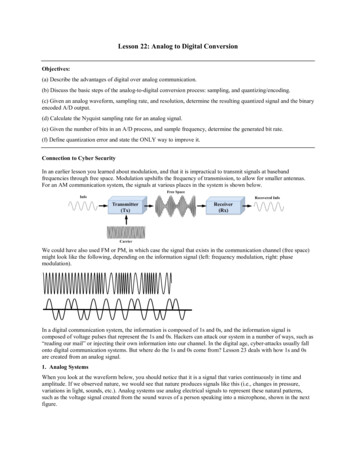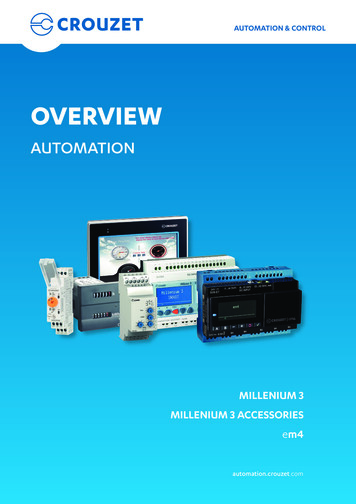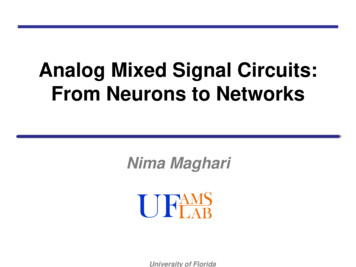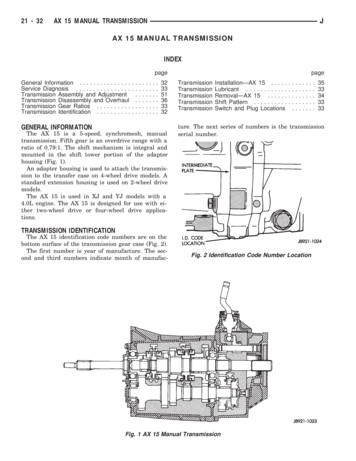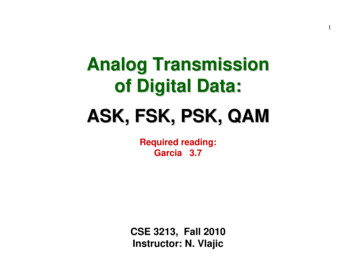
Transcription
1Analog Transmissionof Digital Data:ASK, FSK, PSK, QAMRequired reading:Garcia 3.7CSE 3213, Fall 2010Instructor: N. Vlajic
Why Do We Need Digital-to-Analog Conversion?!1) The medium/channel is band pass, and/or2) Multiple users need to share the medium.2
Modulation of Digital Data3Modulation – process of converting digital data or a low-passanalog to band-pass (higher-frequency) analog signalDigital-to-analog modulation.Analog-to-analog modulation.Carrier Signal – aka carrier freq. or modulated signal - high freq.signal that acts as a basis for the information signal information signal is called modulating signalbandpass channelfreq
Modulation of Digital Data (cont.)4Digital-to-Analog – process of changing one of the characteristicof an analog signal (typically a sinewave) basedModulationon the information in a digital signal sinewave is defined by 3 characteristics (amplitude,frequency, and phase) digital data (binary 0 & 1)can be represented by varying any of the three application: transmission of digital data overtelephone wire (modem)Types of Digital-to-AnalogModulation
Modulation of Digital Data: ASK5ASK – strength of carrier signal is varied to represent binary 1 or 0 both frequency & phase remain constant while amplitude changes commonly, one of the amplitudes is zerobinary 0 A 0cos(2πfc t), binary 0 0,s(t) Acos(2πfc t), binary 1 A 1 cos(2πfc t), binary 1 AIs this picture,from the textbook,entirely correct?!-A demodulation: only the presence or absence of a sinusoid in agiven time interval needs to be determined advantage: simplicity disadvantage: ASK is very susceptible to noise interference –noise usually (only) affects the amplitude, therefore ASK is themodulation technique most affected by noise application: ASK is used to transmit digital data over optical fiber
Modulation of Digital Data: ASK (cont.)Example [ ASK ]vd(t)vc(t)vASK(t)vd(f)vc(f)fHow does the frequency spectrum of vASK(t) look like!?6
Modulation of Digital Data: ASK (cont.)ASK-Modulated Signal: Frequency SpectrumcosA cosB 1(cos(A - B) cos(A B))2Carrier signal:v c (t) cos(2πfc t) cos(ωc t) , where 2πfc ωcDigital signal:(unipolar!!!)22 1 2 cos3ω0 t cos5ω0 t . v d (t) A cosω0 t 3π5π 2 π Modulated signal:v ASK (t) v c (t) v d (t) 22 1 2 cos3ω0 t cos5ω0 t . cosωc t cosω0 t 3π5π 2 π 122 cosωc t cosωc t cosω0 t cosωc t cos3ω0 t . 2π3π11 cosωc t [cos(ωc ω0 )t cos(ωc ω0 )t ] 2π1[cos(ωc 3ω0 )t cos(ωc 3ω0 )t ] . 3πωd maxωcωωc-ωd max ωc ωc ωd max ω7
8Modulation of Digital Data: FSKFSK – frequency of carrier signal is varied to represent binary 1 or 0 peak amplitude & phase remain constant during each bit interval Acos(2 πf1t), binary 0s(t) Acos(2 πf2 t), binary 1f1 f2 A-A demodulation: demodulator must be able to determine which oftwo possible frequencies is present at a given time advantage: FSK is less susceptible to errors than ASK – receiverlooks for specific frequency changes over a numberof intervals, so voltage (noise) spikes can be ignored disadvantage: FSK spectrum is 2 x ASK spectrum application: over voice lines, in high-freq. radio transmission, etc.
9Modulation of Digital Data: FSK (cont.)Example [ FSK ]vd(t)vc1(t)vc2(t)vFSK(t)ωd maxω1ω2ωω1-ωd maxω1ω2 ω ω2d maxω
Modulation of Digital Data: FSK (cont.)FSK-Modulated Signal: Frequency SpectrumDigital signal:v d (t) - modulated with ω1 , andv d ' (t) 1- v d (t) - modulated with ω2Modulated signal:v FSK (t) cosω1t v d (t) cosω 2 t (1 v d (t)) 22 1 2cos3ω0 t cos5ω0 t . cosω1t cosω0 t 3π5π 2 π22 1 2 cos3ω0 t cos5ω0 t . cosω2 t cosω0 t 5π3π 2 π .11 cosω1t [cos(ω1 ω0 )t cos(ω1 ω0 )t ] 2π1[cos(ω1 3ω0 )t cos(ω1 3ω0 )t ] . 3π11cosω 2 t [cos(ω2 ω0 )t cos(ω2 ω0 )t ] 2π1[cos(ω2 3ω0 )t cos(ω2 3ω0 )t ] . 3π10
Modulation of Digital Data: PSK11PSK – phase of carrier signal is varied to represent binary 1 or 0 peak amplitude & freq. remain constant during each bit interval example: binary 1 0º phase, binary 0 180º (πrad) phase PSK is equivalent to multiplying carrier signal by 1 when theinformation is 1, and by -1 when the information is 0binary 1 Acos(2 πfc t),s(t) Acos(2 πfc t π ), binary 02-PSK, orBinary PSK,since only 2different phasesare used. Acos(2 πfc t),s(t) - Acos(2 πfc t),binary 1 A-Abinary 0 demodulation: demodulator must determine the phase of receivedsinusoid with respect to some reference phase advantage: PSK is less susceptible to errors than ASK, while itrequires/occupies the same bandwidth as ASK more efficient use of bandwidth (higher data-rate)are possible, compared to FSK !!! disadvantage: more complex signal detection / recovery process,than in ASK and FSK
Modulation of Digital Data: PSK (cont.)Example [ PSK ]vd(t)vc(t)vPSK(t)ωd maxωcωωc-ωd max ωc ωc ωd max ω12
Modulation of Digital Data: PSK (cont.)PSK Detectioncos 2 A 1(1 cos 2A )2– multiply the received / modulated signal Acos(2 πfc t) by 2*cos(2πfct) resulting signal2Acos 2 (2πfc t) A[1 cos(4 πfc t)] , binary 1- 2Acos 2 (2πfc t) A[1 cos(4 πfc t)] , binary 0 by removing the oscillatory part with alow-pass filter, the original baseband signal(i.e. the original binary sequence) can beeasily determined13
Modulation of Digital Data: PSK (cont.)InformationBasebandSignal10110141 t) A-AA cos(2πft)-A cos(2πft)A {1 cos(4πft)} -A {1 cos(4πft)}receiverAfter multiplicationat receiverx(t) cos(2πfct)Basebandsignal discernableafter smoothingSignal shifted above / below zero level. A-A0T2T3T4T5T6T0T2T3T4T5T6T A-A
15Modulation of Digital Data: PSK (cont.)Facts from Modulation TheoryIfBaseband signal x(t) withbandwidth Wc/2Data rate 2*Wc/2 B [bps]Wc/2fBthenWcModulated signalx(t)cos(2πfct) hasbandwidth Wc Hz ffc-Bfcfc BIf bandpass channel has bandwidth Wc [Hz], then baseband channel has Wc/2 [Hz] available, so modulation system supports 2*(Wc/2) Wc [pulses/second] recall Nyqyist Law: baseband transmission system of bandwidth Wc [Hz]can theoretically support 2 Wc pulses/secHow can we recover the factor 2 in supported data-rate !?
Modulation of Digital Data: PSK (cont.)16QPSK 4-PSK – PSK that uses phase shifts of 90º π/2 rad 4different signals generated, each representing 2 bits Acos(2πfc t), Acos(2πfc t π ), 2s(t) Acos(2πfc t π ), 3π Acos(2πfc t ),2 binary 00binary 01binary 10binary 11 advantage: higher data rate than in PSK (2 bits per bitinterval), while bandwidth occupancy remains the same 4-PSK can easily be extended to 8-PSK, i.e. n-PSK however, higher rate PSK schemes are limited by theability of equipment to distinguish small differences inphase
Modulation of Digital Data: QAM17Quadrature – uses “two-dimensional” signallingAmplitude original information stream is split into two sequences thatconsist of odd and even symbols, e.g. Bk and AkModulation1 0 11 0 1 (QAM) 1-111-11B1A1B2A2B3A3 Ak sequence (in-phase comp.) is modulated by cos(2 πfc t)Bk sequence (quadrature-phase comp.) is modulated bysin(2πfc t) composite signal A cos(2 πf t) B sin(2 πf t) is sentkckcthrough the channelAkxYi(t) Ak cos(2πfct) cos(2πfct)BkxYq(t) Bk sin(2πfct)Y(t) Ak cos(2πfct) Bk sin(2πfct)TransmittedSignalsin(2πfct) advantage: data rate 2 bits per bit-interval!
Modulation of Digital Data: QAM (cont.)Example [ QAM ]Bksin(ωct)Akcos(ωct)vd(t)18
19Modulation of Digital Data: QAMQAM Demodulation A k cos(2 πfc t) Bk sin(2 πfc t) Y(t)by multiplying Y(t) by 2 cos(2 πfc t) and then lowpass filtering the resultant signal, sequence Ak isobtainedby multiplying Y(t) by 2 sin(2 πfc t) and then lowpass filtering the resultant signal, sequence Bk isobtainedx2cos(2πfct)x1(1 cos(2A))21sin2 (A) (1 cos(2A))2cos 2 (A) sin(2A) 2Akcos2(2πfct) 2Bk cos(2πfct)sin(2πfct) Ak {1 cos(4πfct)} Bk {0 sin(4πfct)}Lowpassfilter(smoother)smoothed to zeroBk2Bk sin2(2πfct) 2Ak cos(2πfct)sin(2πfct) Bk {1 - cos(4πfct)} Ak {0 sin(4πfct)}smoothed to zero
Signal Constellation20Constellation Diagram – used to represents possible symbols that maybe selected by a given modulation scheme aspoints in 2-D plane X-axis is related to in-phase carrier: cos(ωct) the projection of the point on the X-axis definesthe peak amplitude of the in-phase component Y-axis is related to quadrature carrier: sin(ωct) the projection of the point on the Y-axis definesthe peak amplitude of the quadrature component the length of line that connects the point tothe origin is the peak amplitude of the signalelement (combination of X & Y components) the angle the line makes with the X-axis is thephase of the signal element
21Modulation of Digital Data: QAMQAM cont. – QAM can also be seen as a combination of ASK & PSK(2Y(t) A k cos(2πfc t) Bk sin(2πfc t) A k BkBk(-A,A)(A, A)Ak4-level QAM(-A,-A)(A,-A)) cos(2πf t tan12 2c-1Bk)Ak
22Modulation of Digital Data: QAM16-level QAM – the number of bits transmitted per T [sec] intervalcan be further increased by increasing the numberof levels used in case of 16-level QAM, Ak and Bk individually canassume 4 different levels: -1, -1/3, 1/3, 1 data rate: 4 bits/pulse 4W bits/second(2Y(t) A k cos(2πfc t) Bk sin(2πfc t) A k Bk) cos(2πf t tan12 2c-1Bk)AkBkAkAk and Bk individuallycan take on 4 different values;the resultant signal can takeon (only) 3 different values!!!In QAM various combinations of amplitude and phase are employedto achieve higher digital data rates.Amplitude changes are susceptible to noise the number of phase shifts usedby a QAM system is always greater than the number of amplitude shifts.
looks for specific frequency changes over a number of intervals, so voltage (noise) spikes can be ignored disadvantage: FSK spectrum is 2 x ASK spectrum application: over voice lines, in high-freq. radio transmission, etc. Acos(2 f t), binary 1 Acos(2 f t), binary 0 s(t) 2 1 π π f 1 f 2 A-A

